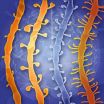(Press-News.org) AMES, Iowa – By blending optical and atomic force microscope technologies, Iowa State University and Ames Laboratory researchers have found a way to complete 3-D measurements of single biological molecules with unprecedented accuracy and precision.
Existing technologies allow researchers to measure single molecules on the x and y axes of a 2-D plane. The new technology allows researchers to make height measurements (the z axis) down to the nanometer – just a billionth of a meter – without custom optics or special surfaces for the samples.
"This is a completely new type of measurement that can be used to determine the z position of molecules," said Sanjeevi Sivasankar, an Iowa State assistant professor of physics and astronomy and an associate of the U.S. Department of Energy's Ames Laboratory.
Details of the technology were recently published by the journal Nano Letters. Co-authors of the study are Sivasankar; Hui Li, an Iowa State post-doctoral research associate in physics and astronomy and an associate of the Ames Laboratory; and Chi-Fu Yen, an Iowa State doctoral student in electrical and computer engineering and a student associate of the Ames Laboratory.
The project was supported by lab startup funds from Iowa State University and a $120,075 grant from the Grow Iowa Values Fund, a state economic development program.
Sivasankar's research program has two objectives: to learn how biological cells adhere to each other and to develop new tools to study those cells.
That's why the new microscope technology – called standing wave axial nanometry (SWAN) – was developed in Sivasankar's lab.
Here's how the technology works: Researchers attach a commercial atomic force microscope to a single molecule fluorescence microscope. The tip of the atomic force microscope is positioned over a focused laser beam, creating a standing wave pattern. A molecule that has been treated to emit light is placed within the standing wave. As the tip of the atomic force microscope moves up and down, the fluorescence emitted by the molecule fluctuates in a way that corresponds to its distance from the surface. That distance can be compared to a marker on the surface and measured.
"We can detect the height of the molecule with nanometer accuracy and precision," Sivasankar said.
The paper reports that measurements of a molecule's height are accurate to less than a nanometer. It also reports that measurements can be taken again and again to a precision of 3.7 nanometers.
Sivasankar's research team used fluorescent nanospheres and single strands of DNA to calibrate, test and prove their new instrument.
Users who could benefit from the technology include medical researchers who need high-resolution data from microscopes. Sivasankar thinks the technology has commercial potential and is confident it will advance his own work in single molecule biophysics.
"We hope to use this technology to move that research forward," he said. "And in doing that, we'll continue to invent new technologies."
INFORMATION:
Contacts:
Sanjeevi Sivasankar, Physics and Astronomy, Ames Laboratory, 515-294-1220, sivasank@iastate.edu
Eddie Boylston, Office of Intellectual Property and Technology Transfer, 515-294-3621, latinusb@iastate.edu
Mike Krapfl, News Service, 515-294-4917, mkrapfl@iastate.edu
Iowa State, Ames Lab researchers invent new tool to study single biological molecules
2012-08-03
ELSE PRESS RELEASES FROM THIS DATE:
Fragile X and Down syndromes share signalling pathway for intellectual disability
2012-08-03
HEIDELBERG, 3 August 2012 – Intellectual disability due to Fragile X and Down syndromes involves similar molecular pathways report researchers in The EMBO Journal. The two disorders share disturbances in the molecular events that regulate the way nerve cells develop dendritic spines, the small extensions found on the surface of nerve cells that are crucial for communication in the brain.
"We have shown for the first time that some of the proteins altered in Fragile X and Down syndromes are common molecular triggers of intellectual disability in both disorders," said ...
Aurka-to-p53 signaling: A link between stem cell regulation and cancer
2012-08-03
Researchers at Mount Sinai School of Medicine, the University of Manchester, and the MD Anderson Cancer Center have found a new role for an oncogenic signaling pathway in embryonic stem cell (ESC) self-renewal and in reprogramming adult cells into an ESC-state, which will aid in the development of future cancer therapies.
The findings promote the understanding of the self-renewal mechanism in embryonic stem cells and provide insight into the role of Aurka, an oncoprotein that is amplified in several human cancers. The research is published in the August 3rd issue of ...
Birds that live with varying weather sing more versatile songs
2012-08-03
Durham, NC — A new study of North American songbirds reveals that birds that live with fluctuating weather are more flexible singers.
Mixing it up helps birds ensure that their songs are heard no matter what the habitat, say researchers at Australian National University and the National Evolutionary Synthesis Center.
To test the idea, the researchers analyzed song recordings from more than 400 male birds spanning 44 species of North American songbirds — a data set that included orioles, blackbirds, warblers, sparrows, cardinals, finches, chickadees and thrushes.
They ...
Ancient records shed light on Italian earthquakes (Aquila area)
2012-08-03
When a damaging earthquake struck the area of L'Aquila in central Italy in 2009, it was the latest in the region's long history of strong and persistent quakes. The rich recorded history of settlement in the area, along with oral traditions, archaeological excavations, inscriptions and medieval texts, and offer insight into how often the region might expect destructive earthquakes. But according to a new study by Emanuela Guidoboni and colleagues, the historical record on ancient and medieval earthquakes comes with its own shortcomings that must be addressed before the ...
Catching the cap-snatcher
2012-08-03
Researchers at the European Molecular Biology Laboratory (EMBL) in Grenoble, France, have determined the detailed 3-dimensional structure of part of the flu virus' RNA polymerase, an enzyme that is crucial for influenza virus replication. This important finding is published today in PLoS Pathogens. The research was done on the 2009 pandemic influenza strain but it will help scientists to design innovative drugs against all the different influenza strains, and potentially lead to a new class of anti-flu drugs in the next 5-10 years.
The scientists focused on the endonuclease ...
Aerial photos reveal dynamic ice sheet
2012-08-03
Despite the current and rapid melting of the Greenland Ice Sheet, it remains far from certain just when we will have reached a point when scientists will be able to predict its disappearance. Recent research conducted by the University of Copenhagen in conjunction with the Technical University of Denmark (DTU) and the Danish National Survey and Cadastre (KMS) in collaboration with an international team of scientists reports that this is not the first time in recent history that the ice sheet has been in retreat and then stabilised again. The researchers' results have just ...
Alzheimer's cognitive decline slows in advanced age
2012-08-03
The greatest risk factor for Alzheimer's disease (AD) is advancing age. By age 85, the likelihood of developing the dreaded neurological disorder is roughly 50 percent. But researchers at the University of California, San Diego School of Medicine say AD hits hardest among the "younger elderly" – people in their 60s and 70s – who show faster rates of brain tissue loss and cognitive decline than AD patients 80 years and older.
The findings, reported online in the August 2, 2012 issue of the journal PLOS One, have profound implications for both diagnosing AD – which currently ...
Plant-based compound slows breast cancer in a mouse model
2012-08-03
The natural plant compound phenethyl isothiocyanate (PEITC) hinders the development of mammary tumors in a mouse model with similarities to human breast cancer progression, according to a study published August 2 in the Journal of the National Cancer Institute.
Edible plants are gaining ground as chemopreventative agents. PEITC has shown to be effective as a chemopreventative agent in mice for colon, intestinal, and prostate cancer, by inducing apoptosis.
In order to determine the efficacy of PEITC in mammary tumors in mice, Shivendra V. Singh, Ph.D., of the University ...
Cuckoo tricks to beat the neighborhood watch
2012-08-03
To minimise the chance of being recognised and thus attacked by the birds they are trying to parasitize, female cuckoos have evolved different guises. The new research, funded by the Natural Environment Research Council, was published today, 03 August, in the journal Science.
The common cuckoo (Cuculus canorus) lays its eggs in the nests of other birds. On hatching, the young cuckoo ejects the host's eggs and chicks from the nest, so the hosts end up raising a cuckoo chick rather than a brood of their own. To fight back, reed warblers (a common host across Europe) have ...
Breast cancer charity under fire for overstating the benefits of screening
2012-08-03
Professors Lisa Schwartz and Steven Woloshin of the Center for Medicine and the Media at The Dartmouth Institute for Health Policy and Clinical Practice argue that last year's breast cancer awareness month campaign by Susan G Komen for the Cure "overstates the benefit of mammography and ignores harms altogether."
Their views are published on bmj.com today as part of an occasional series highlighting the exaggerations, distortions, and selective reporting that make some news stories, advertising, and medical journal articles "not so."
A growing and increasingly accepted ...

